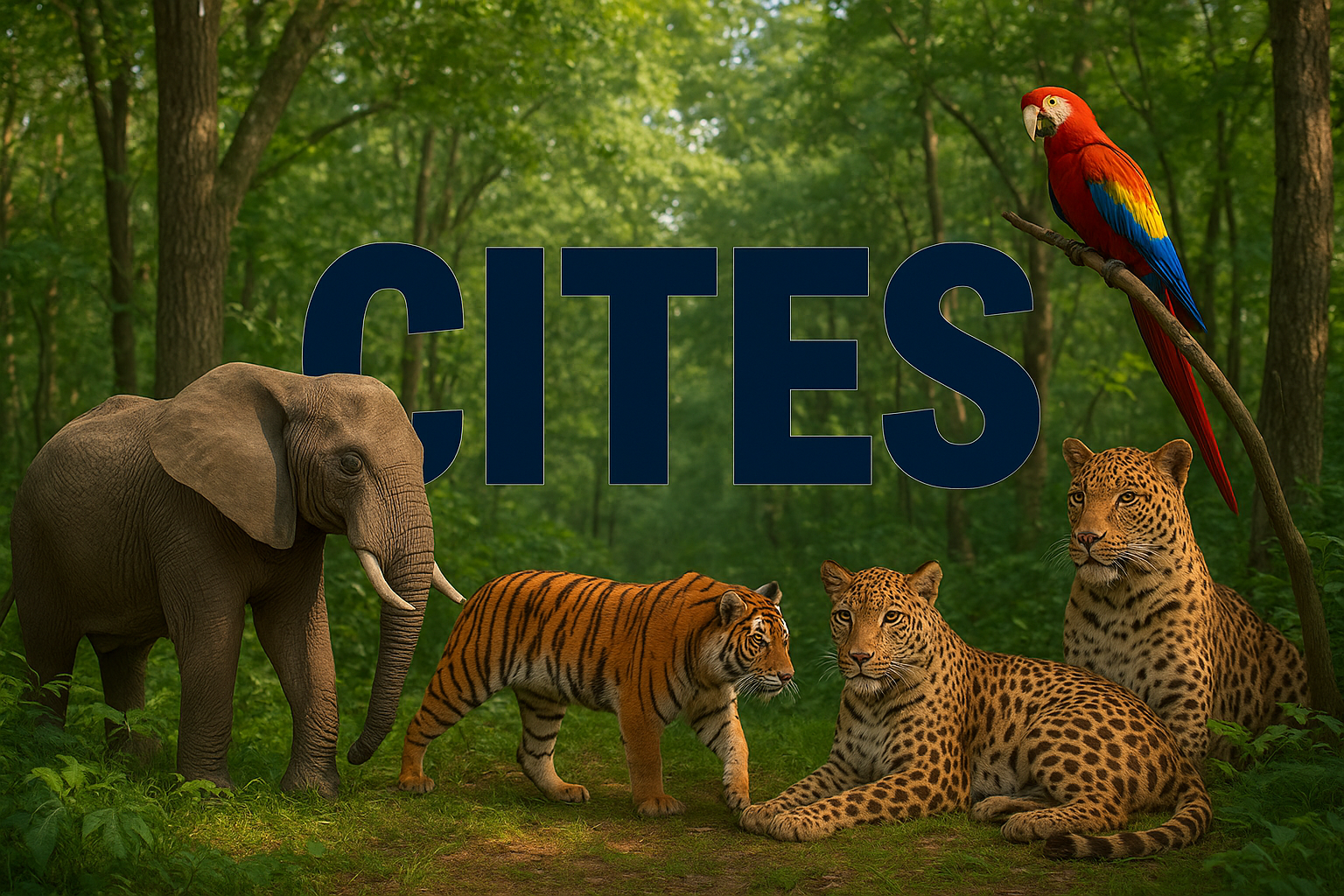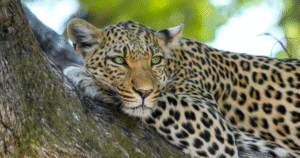Even though our beautiful planet, Earth, is providing all necessary and welcoming conditions for any kind of life to grow and thrive, it is, unfortunately the same place where wildlife is facing relentless threats from poaching, illegal trade, and habitat loss, due to various activities of human beings. Therefore taking ownership of the same and formulating strategies to prevent extinction of any kind of animal race is of utmost importance. The Convention on International Trade in Endangered Species (CITES) emerges as a global safeguard, uniting nations to ensure trade never drives species toward extinction.
What is CITES?
CITES, as the name itself suggests, is a global agreement among member countries, that promises to protect and conserve more than 40,900 species by following a system of certificates and permits. The resolution to the agreement was adopted in 1963, was made available for sanction in 1973 and finally came into force on 1st of July, 1975.
The treaty provides strict regulation of any kind of threat on the survival of endangered plants and animals in the wild due to international wildlife trade. The Secretary General of CITES, as on December 2024 is Ivonne Higuero and as per the data of June 2025, the convention has 185 member countries, that includes 184 states and the European Union.
Why CITES Was Needed?
Here, let us understand what international wildlife trade means and what are its consequences.
This arrangement of trade leads to exchange of a wide range of wildlife plants and animals worth millions of dollars, which can be either in living form or products made out of them. These products include food, ornaments, accessories, musical instruments, curios, or even medicines. Species like elephants, tigers, rhinos, and exotic birds are commonly hunted for ivory, skins, pets, and ornaments.
This leads to overexploitation of such animal and plant species, making them endangered and vulnerable to extinction. Over the years, many such wildlife varieties have been exploited, and are now in the verge of vanishing from the earth completely, disturbing the overall ecological balance.
Here, CITES acts as a legally binding agreement, with a set of minimum standards to be followed in international wildlife trade, so that the survival of those species are not threatened. Over the years, CITES has included a larger number of species, which were previously considered not in danger of extinction. The effort of international cooperation in regulating wildlife trade is of utmost importance since it involves cross-border trade between countries.
How CITES Works: The Framework
The strength of CITES lies in its structured framework that regulates international wildlife trade without completely banning it, unless absolutely necessary. At the heart of this system are the three Appendices, which classify species according to the level of threat they face.
Appendix I includes species that are on the brink of extinction, such as tigers, gorillas, and certain species of sea turtles. Trade in these animals or their parts is prohibited, except under exceptional circumstances like scientific research.
Appendix II covers species not yet critically endangered but that could become so if trade is not controlled—examples include corals, certain reptiles, and many types of plants. Trade is allowed but strictly monitored through permits.
Appendix III lists species protected within at least one country, where cooperation is sought from other nations to regulate their trade.
To ensure compliance, CITES requires export and import permits, issued only when trade will not harm the survival of the species. Each member country, called a Party, must establish national authorities to implement these rules.
Overseeing this vast network is the CITES Secretariat in Geneva, which facilitates cooperation, organizes conferences, and ensures that nations remain accountable to the treaty’s objectives.
Major Success Stories of CITES
No doubt, the mission of CITES is quite a challenging one. Implementing rules and regulations related to trade of wild species at a global level so that their survival is not threatened, is not a very easy task.
But CITES has repeatedly proved its ability to make human activities compatible with the conservation of flora and fauna. This has also, directly or indirectly, helped in alleviating poverty and maintaining global biodiversity.
Some prominent success stories include the Nile Crocodile recovery and the protection of South American vicuna, which is a type of species of the camel family.
1.Nile Crocodile Conservation:
The Kenya Wildlife Service (KWS), as CITES Management Authority, manages Nile crocodile conservation through regulated harvesting in the Tana River area. Once viewed negatively due to attacks on humans and livestock, crocodiles now provide livelihoods through egg collection, employment, and community benefits like maternity clinics, reducing retaliatory killings.
Ranching companies must release 4% of hatchlings to boost populations, while quotas and closed seasons ensure sustainability. Monitoring and research provide vital data on populations. These initiatives improve local attitudes, align conservation with livelihoods, and prevent poaching, poisoning, and habitat conflict, fostering long-term coexistence and conservation of Nile crocodiles.
Not only in Kenya, the sustainable use and trade in Nile crocodiles in Zimbabwe has provided direct incentives for rural communities to tolerate large populations of a dangerous predator. The income generated is also though to dampen the incentives for local people to engage in illegal wildlife trade including of threatened and charismatic species such as elephants and rhinos. The persistence of crocodiles has also helped to preserve ecosystem services and biodiversity in scarce and vulnerable freshwater habitats.
2.South American Vicuna:
The vicuna, a wild South American camelid and ancestor of the alpaca, lives in the Andes and produces highly prized fine wool. Once reserved for Inca royalty, it was heavily hunted, leaving only 6,000 by 1974. Conservation efforts have revived populations to 350,000, though threats like poaching persist.
But Bolivia, Peru, and neighbors signed Convention for the Conservation and Management of the Vicuña (1969, 1979) to protect vicuñas, later permitting sustainable use. Combined with the efforts of CITES in the entire process and trade laws, these treaties proved highly successful, enabling significant population recovery.
3.Ivory Trade Ban:
CITES also internationally banned trade in ivory in 1989, to prevent illegal hunting and extinction of African and Indian elephants.
However, all of the above requires and will continue to require a rigorous compliance and management from CITES, along with support from local population and institutions. This will not only prevent any kind of human-wildlife conflict, but also create a global awareness and cooperation in reducing demand for illegal products. Properly streamlining the permits and rules laid down by CITES will not only create sustainability benefits for the wildlife, but also for rural communities.
Challenges and Criticisms
Although the agreement is playing and will continue to play a major role in control and prevention of misuse of wildlife and our ecosystem, it is equally important to look into the challenges it faces during the course of its working process.
1.Lack of National Laws and Enforcement:
Studies show that more than half of the Parties to the agreement do not have the following in place:
- A government body or an agency who will directly coordinate with CITES to ensure the country follows and enforces the laws, issues or refuses permits, processes permits and checks whether such trades are sustainable and legal or not.
- Proper rules that prohibit illegal and unsustainable trades.
- Penalties for breaking the laws.
- Laws within the countries that can seize and keep wildlife or plants which are traded illegally to earn profits.
2.Gaps in Law Enforcement:
Thus, the above enforcement gaps have resulted in persisting illegal wildlife trade, worth billions of dollars annually. For instance, ivory trade was banned globally in 1989, but it is still thriving in international markets, putting the life of both Asian and African elephants at stake and on the verge of extinction. Quite similar is the situation with rhino horn and exotic pets.
It is true that such bans have a potential impact on the life of local communities and their cultures and rituals, apart from incurring a huge cost on the process of enforcement of cross-border rules and cooperation, but such banned species trade are a huge threat to the biodiversity. However, to control and combat the illicit ivory trade and trafficking, the National Ivory Action Plans (NIAPs) was set up, which created a pressure on the Parties to CITES to address the situation and tackle the problem.
3.Lack of Focus on Sustainability:
It is also to be noted that CITES concentrates more on preventing unlawful and unsustainable trade of wildlife and less on issues like habitat loss, poverty, efforts to conserve species and promote their sustainable living. Funding is not enough for on-the-ground enforcement of laws, for which bilateral aid is necessary. This is because field protection, implemented by CITES, repeatedly helped save endangered animal population.
Role of CITES in the 21st Century
The role of CITES has evolved over the years. In the 21st century, its surpasses stopping poachers and illegal trading at borders and addresses global challenges.
CITES recognizes climate change, that is making species more vulnerable to overexploitation and cooperating with countries to adopt various environmental strategies.
It is also collaborating with Interpol, the United Nations Office on Drugs and Crime (UNODC), and the World Customs Organization to track and dismantle organized animal trafficking and crime worth billions of dollars.
Apart from the above, technology like DNA barcoding help identify smuggled ivory or bushmeat, while satellite tracking and drones monitor poaching hotspots. It is making efforts towards involving local groups and communities to support both wildlife and human livelihood simultaneously.
How the Public and Nations Can Support CITES
Such a international mission like CITES can only be implemented properly if both individuals and governments of all member countries cooperate with each other in the form of training of border forces and security personnel to implement anti-trafficking rules, impose strict penalty for violation, create public awareness to restrict or stop buying goods made by misusing animals, promoting responsible tourism, and using the funds for conservation.
A lot of power lies in the hand of Non-Government Organizations (NGOs), campaigns for protection of endangered animals, social media, community groups and educational institutions, that can be harnessed, to work under the framework of CITES and safeguard our nature and biodiversity.
Conclusion
The battle against illegal wildlife trade is far from over, but CITES remains humanity’s strongest weapon. In the modern era, CITES is not just a treaty—it’s a global security, environmental, and social safeguard. By uniting global efforts, it protects Earth’s most vulnerable species, proving that conservation and responsible trade can—and must—work hand in hand.



Leave a Reply